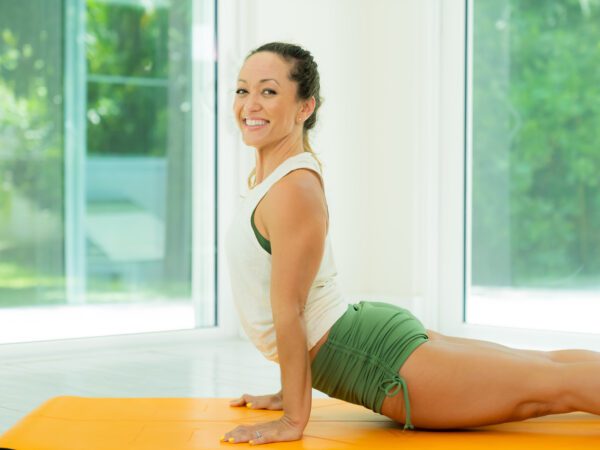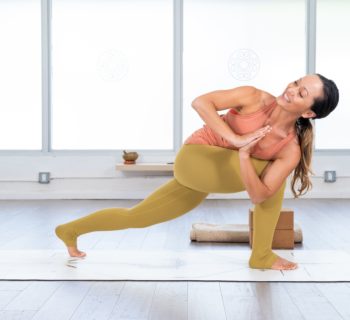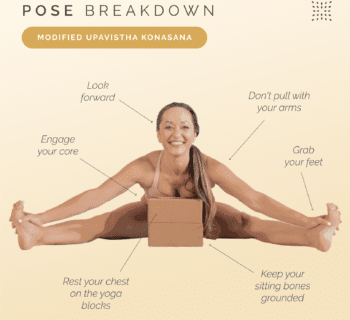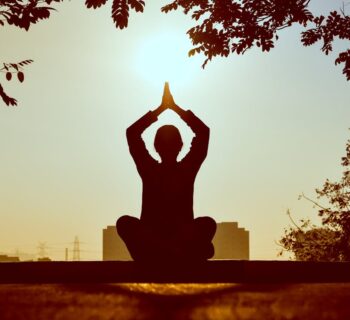Are you struggling to find the right approach to start your Ashtanga yoga practice at home, without an instructor guiding you? Ashtanga is meant to be a self-guided practice, but in the beginning, learning from a qualified instructor can help you avoid common mistakes in your practice. If you don’t have an Ashtanga yoga teacher in your area, joining Omstars will give you instant access to some of the best Ashtanga yoga teachers in the world. They can guide you as you learn the practice no matter where you are.
Establishing a rewarding home practice can feel daunting, but with the right tips and resources, you can enjoy a transformative, self-sustaining Ashtanga yoga experience. Besides finding the right teacher for you, let’s look at some things you can do to make your at-home Ashtanga practice the best it can be.
Setting Up Your Space
You can practice yoga anywhere, but since Ashtanga is meant to be a kind of moving meditation it is good to have a dedicated place free from distractions to practice. Choose a quiet, clutter-free spot that inspires calm, focus, and mindfulness. It doesn’t have to be an entire room. You can just pick a quiet corner in your living room to use for your practice. Natural light, fresh air, and minimal distractions can significantly enhance your experience.
Consider adding inspirational elements like candles, incense, and calming art to that area. This not only sets the mood but also enriches your spiritual connection to the practice. When you step into that space you’ll feel inspired to practice.
Choose a Quiet Area
Creating a tranquil environment is essential for cultivating mindfulness during Ashtanga practice. Your space should be free of distractions, fostering focus and calm. Finding a quiet time to practice can be a struggle when you live with others. You can try getting up earlier than everyone else to practice. You can also try practicing when everyone else is out of the house. If you have young children, you might be able to squeeze a short practice in while they are napping.
Invest in Quality Mat
You don’t have to have a mat to get started but investing in one will be benefitable. Choosing a quality mat ensures comfort, safety, and durability during your Ashtanga practice. Ashtanga involves dynamic movements requiring reliable support and grip. When you’re looking for a mat it’s important to consider these factors:
Non-Slip Surface: Prevents sliding during intensive postures.
Adequate Cushioning: Protects joints from hard surfaces.
Durable Material: Resists wear and tear from frequent use.
Eco-Friendly Options: Made from sustainable materials like natural rubber.
A well-chosen mat enhances balance and stability, allowing deeper focus on poses.
Learning the Basics
When you’re starting with Ashtanga yoga, understanding the foundational postures, or asanas, is essential for establishing a strong practice. Familiarize yourself with the primary series, which includes a dynamic sequence of poses designed to build strength, flexibility, and endurance. Incorporate Ujjayi breath—an energized breath technique—to maintain focus and elevate your practice. Online tutorials and beginner classes can provide a structured approach to mastering these basics for both Ashtanga and vinyasa yoga, while ensuring you align properly to avoid injury.
Start with the Primary Series
Begin with your Ashtanga practice with the primary series, also known as Yoga Chikitsa. This sequence focuses on detoxifying and aligning the body, making it perfect for beginners.
Set a dedicated time each day to maintain consistency. Regular practice is key.
Start with Surya Namaskar A and B (Sun Salutations) to warm up your body thoroughly before moving into the standing postures. In the beginning you might only do the sun salutations. It takes time to build flexibility and strength you need for the full primary series. Taking it one section at a time in the beginning is fine.
Each pose flows seamlessly into the next. Consistently practicing the Primary Series will build a solid foundation and help you to refine your technique. Remember, progress may be slow at the beginning, but dedication will yield significant benefits over time.
Focus on Breath (Ujjayi)
Mastering Ujjayi breath, also known as victorious breath, is crucial for a balanced and focused Ashtanga practice, working in harmony with drishti to maintain steady concentration.
Inhale Deeply: Take slow, deep breaths through your nose, feeling your lungs expand fully.
Constrict Throat: Slightly constrict the back of your throat, creating a soft hissing sound as you breathe.
Maintain Rhythm: Keep a steady and even breath, matching each inhale and exhale with your movements.
Focus Mind: Use the audible breath as an anchor to keep your mind centered and present.
Integrating Ujjayi breath aids in oxygenating your muscles and ensuring a smoother flow through each posture.
Consistent practice of this technique boosts stamina, calms the mind, and enhances your overall yoga experience.
Understand Bandhas
The Bandhas, often referred to as energy locks, are fundamental in Ashtanga yoga practice.
There are three primary Bandhas to focus on:
Mula Bandha (root lock) engages the perineum
Uddiyana Bandha (abdominal lock) activates the lower belly
Jalandhara Bandha (throat lock) involves tucking the chin to the chest
Practicing these energy locks not only helps in controlling and directing your prana (life force) but also supports a safer, more effective practice by stabilizing your core, refining your alignment, and aiding in detoxification. Understanding and mastering the Bandhas will enrich your practice, bringing greater power and depth to your Ashtanga journey.
Developing a Routine
Establishing a regular Ashtanga practice at home requires dedication, but the rewards are immense, especially when you can use a browser to access updates and a plethora of resources. Start by setting aside a specific time each day, treating your practice as a non-negotiable appointment with yourself. Consistency in timing helps create a rhythm that becomes naturally ingrained.
To facilitate this routine, carve out a “sacred space” for your practice. This can be as simple as a dedicated yoga mat area free from distractions. In the beginning, focus on the Primary Series, which offers a structured approach that builds strength and flexibility progressively. Over time, this practice space will become a sanctuary where you can deepen your connection with Ashtanga yoga.
Consistent Practice Time
Carving out a specific time each day for Ashtanga yoga is crucial for developing a sustainable home practice.
Choose a Time: Select a time that aligns with your daily schedule and natural energy levels, whether it’s early morning or late evening.
Create a Ritual: Develop pre-practice rituals like lighting a candle or practicing meditation to signal your mind and body it’s yoga time.
Stay Flexible: While consistency is key, allow some flexibility to accommodate life’s unpredictabilities, without letting it derail your routine.
Set Reminders: Use alarms or app notifications to remind you of your practice time, reinforcing the importance of this commitment.
Track Progress: Maintain a journal to note down your practice sessions, challenges, and progress, reinforcing your commitment and growth. By designating a steady practice time, you anchor Ashtanga yoga into your daily life more effectively.
This regularity not only helps in building discipline but also allows you to see incremental progress in your practice.
Know Your Limits
In your Ashtanga journey, it’s essential to know your limits to practice safely and effectively.
As a beginner, you might be eager to master poses quickly, but pushing yourself too hard can lead to injury. Recognize that progress in yoga is non-linear.
Start by listening to your body. If a pose feels uncomfortable or causes pain, modify it or skip it entirely. Over time, your flexibility and strength will improve.
In Ashtanga, each series builds on the previous one. Don’t rush through the sequences; ensure you have a firm foundation before moving on to more advanced poses.
Above all, remember that yoga is a personal journey. Respect your body’s signals and honor where you are in your practice.
Warm-Up Effectively
A proper warm-up is essential for preparing your body and mind for an invigorating Ashtanga practice. It increases blood flow, enhances flexibility, and reduces the risk of injury.
Sun Salutations (Surya Namaskar): Perform 5-10 rounds to awaken your whole body.
Joint Rotations: Roll your neck, shoulders, wrists, and ankles to release tension.
Dynamic Stretching: Incorporate leg swings and torso twists to loosen muscles.
Breath Awareness: Practice deep, controlled breathing (Ujjayi Pranayama) to center your mind.
Start slowly and mindfully, allowing your body to transition gently from a state of rest to a state of activity. This helps prevent strains and enhances your overall performance.
Warming up is not just about flexibility; it also fosters mental readiness, enabling you to engage fully with each pose and transition gracefully through your practice.
Online Classes
Online Ashtanga yoga classes are abundant and accessible for beginners. How do you choose the right one?
Omstars provides a more than 5,000 classes and many teachers for you to practice with. Omstars offers recorded and live classes from certified instructors worldwide. Our classes are tailored for different levels.
Our online classes include detailed guidance on aligning your breath with movement, a fundamental aspect of Ashtanga. They present a tremendous opportunity to practice under the virtual watch of experienced teachers.
Interacting with instructors during live sessions can provide real-time feedback, which is particularly beneficial for correcting postural alignments and honing your technique. Recorded classes allow you the flexibility to practice at your own pace.
Online classes can also introduce you to a global community of fellow enthusiasts, enriching your practice.
Instructional Books
Instructional books serve as an excellent resource, especially for home practitioners who crave structure and guidance.
For Ashtanga beginners, some influential texts are The Power of Ashtanga Yoga by Kino MacGregor, Ashtanga Yoga: The Practice Manual by David Swenson, and Yoga Mala by Sri K. Pattabhi Jois. These books cover fundamentals, including detailed descriptions of postures, breathing techniques, and the philosophical underpinnings of Ashtanga yoga.
Both MacGregor’s and Swenson’s books provide step-by-step instructions, illustrated with photographs, making it easier to understand and visualize each posture. They provide practical tips are perfect for beginners aiming for clarity and confidence in their at-home practice.
Yoga Mala offers deeper insights into the spiritual aspects of Ashtanga, enriching your practice by connecting mind, body, and spirit. Integrating wisdom from these books into your routine ensures a comprehensive approach, aligning your physical movements with a reflective mindset.
Tracking Progress
Monitoring your growth in Ashtanga Yoga is essential to stay motivated. How can you track your progress effectively?
First, maintain a yoga journal. Record the date, duration, and focus of each session, noting any physical or emotional changes. This habit allows you to identify patterns and areas for improvement.
Self-assessment is also valuable. Regularly reflect on your breath control, stability, and mental focus during practice. Use these reflections to fine-tune areas that need attention, striking a balance between physical and mental growth.
Most importantly, be gentle with yourself. Progress isn’t always linear, and small steps forward contribute to long-term transformation. Consistency is key, so celebrate each milestone along your Ashtanga journey.
Embarking on your Ashtanga journey at home can be both exciting and rewarding. By following these essential tips, you’ll set a strong foundation for your practice, ensuring steady progress and deeper connection to your body and mind. Remember, consistency is key, and it’s important to listen to your body and honor its limits. With dedication and patience, you’ll soon experience the transformative benefits of Ashtanga yoga. Happy practicing, Ashtanga beginners!
Are you looking for more guidance on your yoga journey? Sign up for Omstars to get access to thousands of yoga classes in the comfort of your own home. Click here to start your subscription.
Photo by Cliff Booth: https://www.pexels.com/photo/photo-of-women-stretching-together-4056723/









